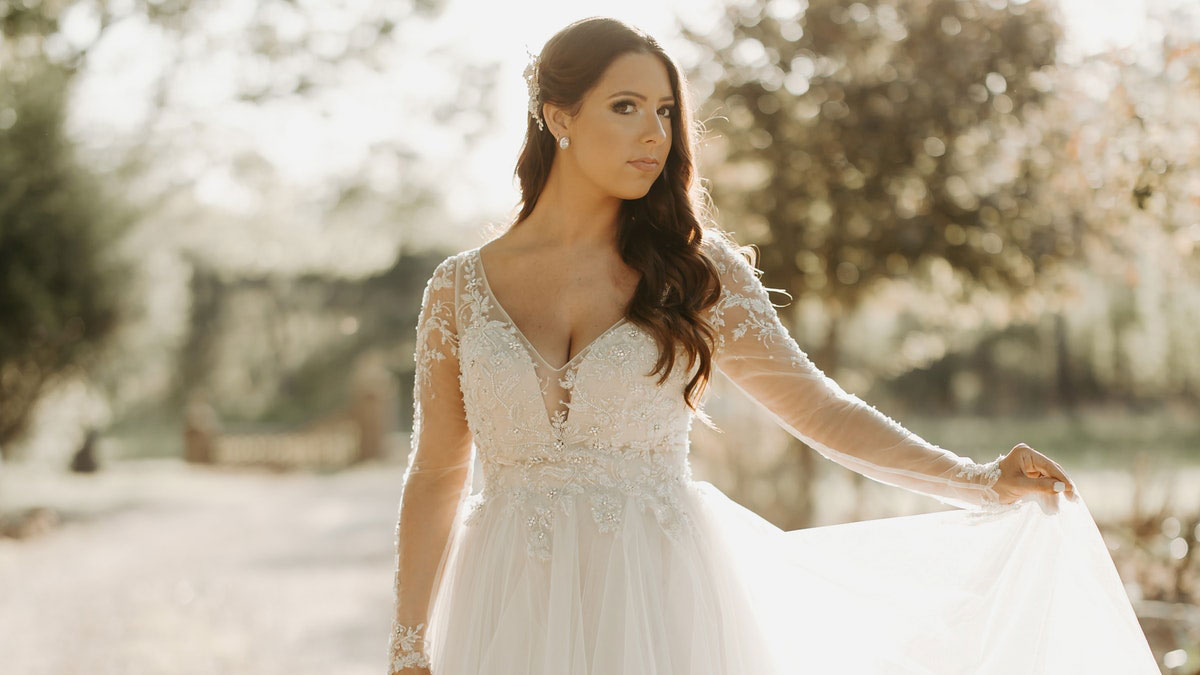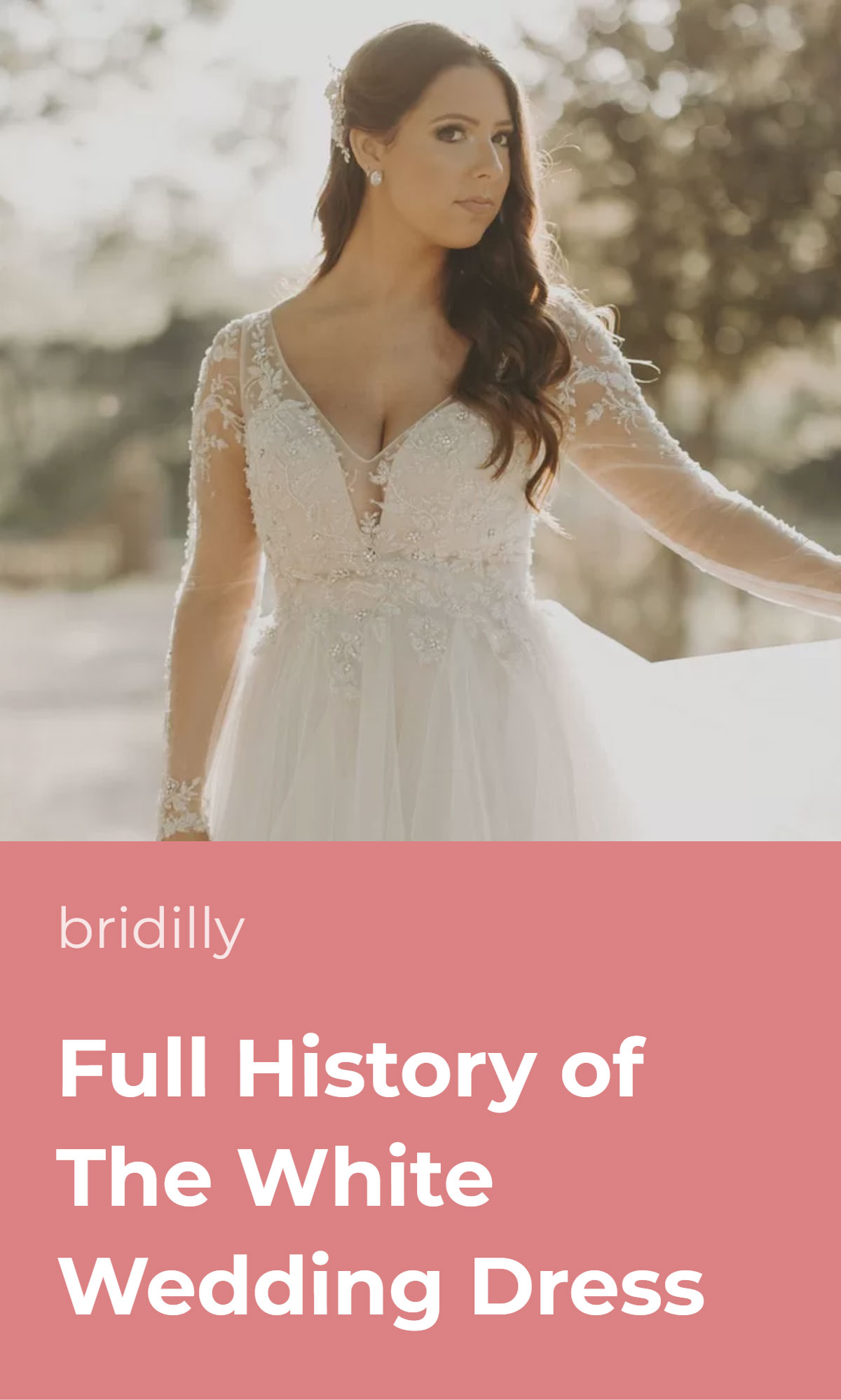Although white is the most popular bridal color among modern western brides, not many are familiar with the white wedding dress history.
Meanwhile, its history is long, fascinating, and often takes unexpected turns.
If your wedding took place a few centuries ago, you would likely wear a red or green velvet gown with a mink collar or a simple cream church dress, depending on your social status.
But the royals have always been trendsetters, and the 20th-century technological development ensured that every woman could look like a queen.
Fashion is cyclic, and nowadays, more and more brides prefer colorful gowns. Still, the white wedding dress trend remains strong, with 82% of American brides sticking to the tradition.
Table of Contents [show]
Wedding Dresses in Ancient Rome
Romans had a significant influence on worldwide culture, and modern bridal wear traditions also stem from ancient times.
Ancient Roman bridal gowns and wedding etiquette overall weren’t much different from what we’re used to today.
A Roman bride would rise early on the morning before the wedding to pick flowers to adorn her intricate hairstyle and hold the veil in place.
Like today, the veil represented the bride’s devotion to her husband but was flaming red rather than white.
As for the bridal gowns, the styles were much more minimalistic than modern wedding dresses: Roman brides wore white tunics with a relaxed silhouette from a muslin-like fabric. Women tied the tunic at the waist with a fabric belt.
The belt was an essential element of the bridal attire, symbolizing the bride’s purity, and was passed on from mother to daughter. This custom resembles the modern “something old, something new” wedding superstition.
Modern brides have a wide selection of white wedding dress shades, such as diamond white, natural white, or ivory.
However, in Ancient Roman times, stark white fabric dye was technologically unachievable, and bridal gowns were off-white.
Interestingly, Roman brides refrained from wearing accessories other than the belt and veil. They were seen as distracting from the most important bridal accessory, the ring.
Old Wedding Gowns Came in All Colors
Although Ancient Roman bridal gowns were similar to modern attires, the custom of wearing white for a wedding was reserved for that region.
Brides in other cultures wore dresses of just about any color, with white being one of the rarest.
In the Middle Ages, marriage was more than a union between two lovers in the western world. It was merely a political and economic union between two families, so the bride’s attire had to showcase her family’s social status.
Women wore their best gowns from luxurious materials in rich colors.
Purple, indigo, and darker shades of green were particularly popular among the nobility and the higher social classes, as these fabric dyes were the hardest to produce and thus the most expensive.
Historical evidence suggests that brides from wealthy families favored velvet, silk, and layers of furs.
Brides from lower social classes usually wore their best church dresses in cream, grey, or brownish colors. Fabric dyes of these colors were the cheapest.
Scandinavian brides admired black and red gowns – fabrics of these colors were seen as a symbol of wealth.
Red and black dyes were made by crushing insects called Kermes that were widespread only in southern regions, so they had to be imported to northern countries.
Brides in some cultures never wore white wedding dresses. For instance, Chinese brides of the 14th century preferred golden yellow gowns.
Red became the traditional Chinese wedding dress color during the rule of the Ming dynasty and remains such to this day.
Indian brides traditionally wore a colorful sari or lehenga. While many modern Indian women wear western-style white dresses, the custom remains widespread among conservative families.
The White Wedding Dress Trend in England
The white wedding dress trend in Europe took off in 1406 when the Queen Philippa of England wore a white silk tunic for her wedding with Eric of Pomerania. Later, Queen Mary of Scots wore a white dress for her wedding in 1559.
Interestingly, white was the color of mourning in France at that time, and Queen Mary’s husband Francis was from France. But historical records suggest that white was the Queen’s favorite color.
The practice of wearing white for a wedding didn’t become widespread until the Victorian Era. This color was unpractical when clean tiled or wooden floors were rare, and weddings were often held outdoors.
Queen Victoria is responsible for many modern customs, particularly Christmas and wedding traditions. She wore a white lace gown for her wedding with Prince Albert of Saxe-Coburg in 1840.
The dress was exquisite even compared to modern wedding gowns, featuring an off-shoulder neckline with puff sleeves, a deep V-cut waistline, and a six-yard train carried by 12 attendants.
The reason Queen Victoria chose a white wedding dress is debated.
Some scholars suggest she wanted to support the declining British lace trade and therefore chose Honiton lace from a small town, Beer. White color was the best way to showcase the lace maker’s artistry.
All media outlets published illustrations of Queen Victoria in her show white dress, and English brides quickly adopted the trend.
However, pure white fabrics were reserved for the nobility, so such wedding gowns remained a symbol of wealth and status rather than purity.
From Symbol of Status to Symbol of Purity
Queen Victoria’s style inspired not solely British brides. Women all around Europe and in the U.S. admired Victoria’s fashion taste and aspired to dress like her.
One of the first historical records of a white wedding dress representing purity dates to the late 1840s.
A popular American women’s magazine, Godey’s Lady’s Book, wrote that white gowns reflected the bride’s virginity since ancient times.
And the magazine wasn’t wrong – although the belief wasn’t widespread in England or the U.S., Roman brides indeed wore white to symbolize purity and innocence.
Several other magazines and newspapers cited the article throughout the following decades, but white gowns remained extremely expensive and didn’t become popular among the middle classes until the 20th century.
The industrial revolution made white fabric production easier, so every woman could afford a white wedding gown after World War ll.
A white wedding dress no longer indicated a high social status of the bride and became a symbol of purity.
White Wedding Dress Evolution
The industrial revolution sped up nylon and rayon production and made exquisite dresses relatively cheap. Fashion trends began to change rapidly – every decade favored different styles and silhouettes.
Brides typically wore minimalistic flowy dresses with dropped waistlines at the start of the century.
In the 1930s, fitted styles with long sleeves and high necklines came into fashion. Wealthy women preferred silk, while those who couldn’t afford it chose rayon.
The trends remained unchanged throughout the 1940s, as people had more important things to care about.
In the 1950s, women worldwide celebrated the end of the war by wearing bountiful ball gowns, often with off-shoulder or strapless necklines.
Overall, the bridal fashion started to move from modest to whimsy and even seductive. With the arrival of the 1960s, wedding dresses got slimmer again – column and mermaid silhouettes were on the surge.
The 1960s womens’ style is characterized by straight silhouettes and short hemlines, and bridal wear is no exception. Mini wedding dresses and mutton sleeves were popular among the trendiest brides.
In the next decade, high-neck and long-sleeve wedding gowns returned, but they were quickly replaced with strapless ball gowns and puff sleeves in the 1980s.
During the 1990s, wedding dress trends weren’t as distinct – brides wore very different gowns, with only one element remaining constant – the color.
White wedding dresses have taken over the western world and become a widespread tradition.
White color meaning aligned so well with the symbolism of marriage that over 90% of the 20th-century brides preferred this hue to any other, regardless of the changing silhouette and fabric trends.
Meanwhile, the 21st-century brides more and more often choose colors that better suit their personalities, although white color remains prevalent.
The Most Famous White Wedding Dresses
Queen Victoria’s wedding gown is among the most famous dresses in history, and it’s no wonder, as it kicked off the white wedding dress tradition. However, it isn’t the only notable white bridal gown.
Many iconic wedding dresses belong to royalty. Perhaps, the best-known examples from the British Royal Family are Queen Elizabeth ll white A-line gown adorned with floral and star appliques and Princess Margaret’s organza ball gown with a deep V-cut neckline.
Grace Kelly’s gown is justifiably considered the most famous wedding dress of all time, made from a combination of silk, taffeta, tulle, and lace.
It featured a ball gown silhouette with a high neck, long shoulders, and long train.
Perhaps, the only white dress from the 20th century that could compete with Grace Kelly’s gown belonged to Diana, Princess of Wales.
It’s an excellent example of the 1980s style featuring a voluminous skirt, open shoulders, and dramatic balloon sleeves.
One of America’s most famous first ladies, Jacqueline Kennedy, chose a dress with a bouffant skirt and intricate draping in 1953.
Audrey Hepburn starred in an iconic tea-length dress with balloon sleeves in a diamond white color a year later.



















No Comments Add one
Leave a Comment